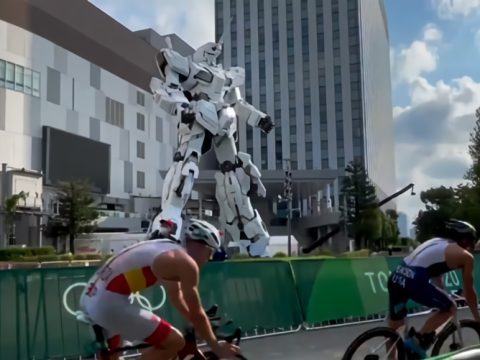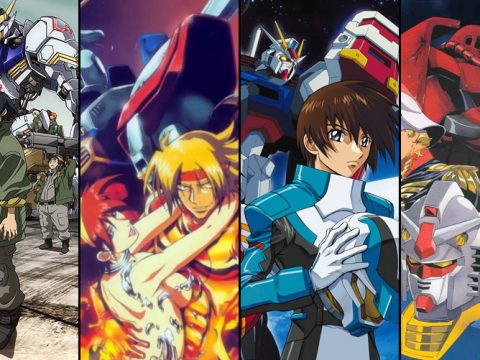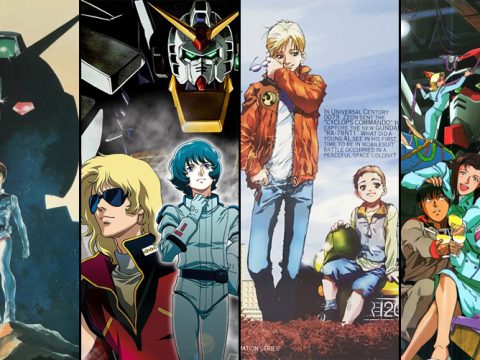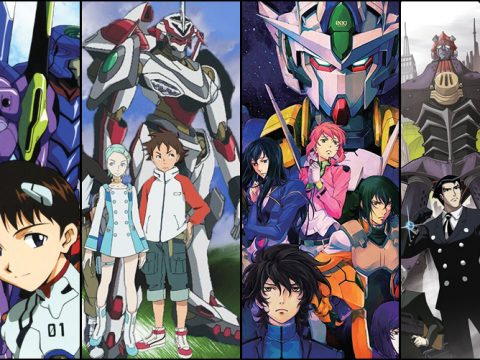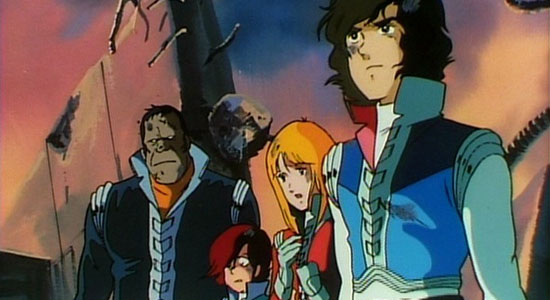
As Right Stuf has just finished releasing the last anime in the Dirty Pair universe from the ’80s needing R1 distribution (namely Dirty Pair TV Collection 2), we thought it was time to look back at its sister series, Crusher Joe, which has been animated as one film and two OVAs (Original Video Animation distributed for home release).
Both series were created by author Haruka Takachiho, an animator who initially started his career working with fellow artists in setting up Crystal Art Studio. Takachiho wanted to do sci-fi but the team wound up doing a children’s anime entitled Zero Tester, and subsequently disbanded after a few projects. Soon after, the group created Studio Nue, for which Takachiho served as president. This crew created mecha and ship designs found in many classic anime, such as Super Dimension Fortress Macross, Aura Battler Dunbine and Galaxy Express 999. Takachiho later pursued his dream of being a sci-fi writer by releasing two novels: Great Adventures of the Dirty Pair and Crusher Joe.
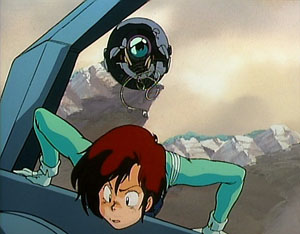 The latter was actually the star of Takachiho’s first novel, “Crisis on Union Planet Pizanne,” which in 1977 introduced readers to a group of intergalactic mercenaries who work for the Crusher Conference organization. This team is one of several who take various jobs including body guarding, search-&-retrieval, transport and just about anything in between. Joe himself is a young man who has taken over active leadership as his father Dan has retired to administrate the Crushers. Joe’s team includes Talos (a veteran cyborg pilot who originally worked with Dan), Alfin (a princess who abdicated her planet to join the team), Ricky (the adolescent engineer) and Dongo (the ship’s robot and scientific analyzer).
The latter was actually the star of Takachiho’s first novel, “Crisis on Union Planet Pizanne,” which in 1977 introduced readers to a group of intergalactic mercenaries who work for the Crusher Conference organization. This team is one of several who take various jobs including body guarding, search-&-retrieval, transport and just about anything in between. Joe himself is a young man who has taken over active leadership as his father Dan has retired to administrate the Crushers. Joe’s team includes Talos (a veteran cyborg pilot who originally worked with Dan), Alfin (a princess who abdicated her planet to join the team), Ricky (the adolescent engineer) and Dongo (the ship’s robot and scientific analyzer).
Takachiho collaborated with his favorite design artist Yoshikazu Yasuhiko (known to his fans as YAS, with whom Takachiho worked on the anime series Brave Raideen) to find success with this novel. They subsequently created the Dirty Pair series, which takes place 20 years before Crusher Joe. The duo produced 10 novels before attempting (at the behest of Nippon Sunrise) the animation scene in 1983 with theatrical release of the Crusher Joe movie.
The film opens with The Crushers on vacation, when they are interrupted by an emergency request for help from a man named Baranchinos. He works for the wealthy Scoran family; the immediate heiress Elena is so sick, she has to be placed in cryogenic suspension for transport to a distant planet for emergency surgery. At the same time, Baranchinos is requesting absolute secrecy because of internal family disputes.
The Crushers take the pair aboard their ship, the Minerva, and everything goes ok until they utilize the warp drive. Inexplicably, The Minerva is stranded and Baranchinos and Elena vanish. To make matters worse, the military appears and boards The Minerva to arrest Joe and company on suspicion of piracy. However, a mysterious man named Bard comes to order their release due to lack of evidence. Dan later reprimands the team and suspends their Crusher license for six months due to Joe acting so rashly. He admonishes Talos in particular since his experience should’ve told him differently.
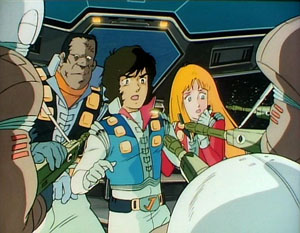 Joe and company head to a disco to relieve stress and wind up in a drunken brawl. In the midst of this, Bard approaches Talos due to their past association (as Bard is revealed as an ex-Crusher now working for Intelligence) to discuss their last job. It turns out Baranchinos is actually an outlaw named Yosef Dodge hiding in a different star system where the military and galactic police have no jurisdiction. The Crushers have no restraints, however, and head to this system immediately.
Joe and company head to a disco to relieve stress and wind up in a drunken brawl. In the midst of this, Bard approaches Talos due to their past association (as Bard is revealed as an ex-Crusher now working for Intelligence) to discuss their last job. It turns out Baranchinos is actually an outlaw named Yosef Dodge hiding in a different star system where the military and galactic police have no jurisdiction. The Crushers have no restraints, however, and head to this system immediately.
This is where the crew has the first of several battles against The Murphy Pirates. After things get tough, they’re offered help from President Mardora, with whom the crew meets secretly at a drive-in theater. Mardora asks him to sanction Murphy in exchange for detailed information about the pirates’ base. Joe balks at assassination but agrees to bring Murphy back alive. However, the attack on the base goes badly as Ricky and Talos are captured. On the other hand, they escape with the recently revived Elena who actually carries a devastating secret the Pirates will exploit recklessly… unless Crusher Joe stops them first.
Takachiho once said in an interview his written works don’t really translate well to animation. Although history would later prove him wrong, this particular piece somewhat bore out that line of thinking. The Crusher Joe movie takes a long while to get to its main focus. The screenplay progresses slowly at times and although there are action scenes, they don’t totally feel in balance with the film’s overall development. Yasuhiko served as director and his abilities as a storyteller are somewhat hampered by the film’s 130-minute running time, which seems to have been conceived to compete against other lengthy space opera fare prevalent in that period, like the Mobile Suit Gundam and Space Runaway Ideon film compilations. Crusher Joe was also facing other heavy hitters during the summer of ’83 such as Final Yamato and Harmageddon, both of which were well-received. In short, although it was a decently entertaining work with quality animation techniques for its time—earning it the Anime Grand Prix prize from Animage Magazine—the Crusher Joe movie itself wasn’t quite the home run its producers were hoping for, and further animated adventures were shelved for a while.
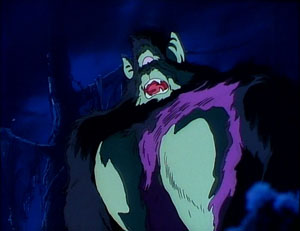 As classic anime fans are often aware, this movie bore an unexpected fruit in that it depicted the first animated appearance of the Dirty Pair (shown in the movie at the drive-in where Joe’s team met Mardora). This created a lot of buzz in Japan leading to the production of the 1985 Dirty Pair TV series, and subsequently several successful projects. This success prompted Sunrise and Takachiho to try again with Crusher Joe in a different format, with much better results.
As classic anime fans are often aware, this movie bore an unexpected fruit in that it depicted the first animated appearance of the Dirty Pair (shown in the movie at the drive-in where Joe’s team met Mardora). This created a lot of buzz in Japan leading to the production of the 1985 Dirty Pair TV series, and subsequently several successful projects. This success prompted Sunrise and Takachiho to try again with Crusher Joe in a different format, with much better results.
In 1989, the 59-minute OVA Crusher Joe: The Ice Prison was released depicting a new adventure for the team. We are shown the area Uuben on the planet Kirius, where the population are holding a massive protest against its dictatorial leader Ghellstan. In space, aboard a comet called Devil, administrators of the prison mine The Ice Castle rule their inmates harshly. Elsewhere, a laser is being worked on when it suddenly turns and fires into the mine, killing several of the workers and altering the comet’s course toward Kirius…
Meanwhile, The Crushers are taking a vacation on a luxury planet when they see a news broadcast about the troubles in Uuben. The Crusher Conference calls Joe’s team to commence rescue efforts, but they’ve just come off some long-term guard duty and would rather have another team handle the situation. However, since the vacation planet is closest to Uuben, Joe and company are assigned to the task.
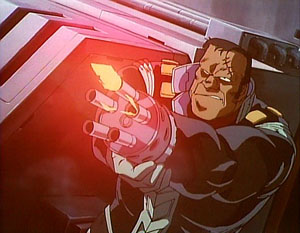 En route, the team wonders why Ghellstan would hire Crushers to rescue the prisoners inside Devil before it crashes on the planet, when these very same prisoners protested against Ghellstan. They bring up these concerns when they meet Chief Officer Hume of the Kirius government who’s come to oversee the operation. He tells them the population’s concerns about the government are unfounded and they’re not as heartless as the protestors would have everyone think; Ghellstan indeed cares about all of the citizens of Kirius. The Crushers are not particularly convinced (especially after Hume questions the age and advanced knowledge of the Crushers), but they can’t deny the fact there are people who need help and set about doing the job.
En route, the team wonders why Ghellstan would hire Crushers to rescue the prisoners inside Devil before it crashes on the planet, when these very same prisoners protested against Ghellstan. They bring up these concerns when they meet Chief Officer Hume of the Kirius government who’s come to oversee the operation. He tells them the population’s concerns about the government are unfounded and they’re not as heartless as the protestors would have everyone think; Ghellstan indeed cares about all of the citizens of Kirius. The Crushers are not particularly convinced (especially after Hume questions the age and advanced knowledge of the Crushers), but they can’t deny the fact there are people who need help and set about doing the job.
What follows is an adventure of space battles, double crosses, and desperation against the odds. Joe himself is focused on the rescue efforts so his crew gets to do much of the fighting. The screenplay is primarily plot driven (though with good action sequences) and built on growing tensions between the Crushers (along with the prisoners) and Ghellstan’s forces who attempt to sabotage the rescue right from the start. The overall pacing is better than the movie in that there’s a short setup and then gets right to business. Some of the fight scenes could’ve been longer but it’s still a good installment.
Several months later in ’89, the last animated adventure to date was released to home video. Crusher Joe: Ultimate Weapon ASH opens in the middle of a mutiny. Major Tanya of the Bandor Republic is transporting a portable device called the ASH, a devastating weapon capable of destroying life on an entire planet if activated. However, other officers are fighting to get their hands on it and the ship crashes on the uninhabited planet Davidof.
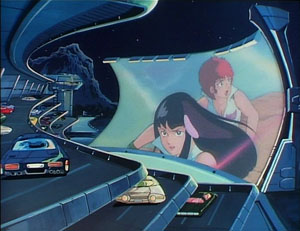 Elsewhere, the president of the republic takes ill and is transported to a local hospital. Aboard the ambulance, he meets The Crushers, whom he called in to clandestinely handle the ASH situation. It turns out the weapon was created at the end of Bandor’s brutal war with Caminas, which has recently halted due to a treaty. If people learn of ASH, the war will restart. So the team is asked to go to Davidof and either retrieve or dispose of this device.
Elsewhere, the president of the republic takes ill and is transported to a local hospital. Aboard the ambulance, he meets The Crushers, whom he called in to clandestinely handle the ASH situation. It turns out the weapon was created at the end of Bandor’s brutal war with Caminas, which has recently halted due to a treaty. If people learn of ASH, the war will restart. So the team is asked to go to Davidof and either retrieve or dispose of this device.
When The Crushers get to Davidof, however, they find a more immediate problem to face, one more lethal than any mutinous soldiers. It turns out there is a weapon system called the Cloakers: self-replicating mini-spheres designed to latch onto any moving target and explode immediately. The system was abandoned for being too dangerous, but since that was a long time back and the replications were never stopped…
As you might imagine, this sets the stage for intense action throughout this video. It grabs you in a choke hold, gets increasingly tighter and doesn’t let go until the very end. Whereas The Ice Prison is more plot driven, ASH is almost all action, with the opening having just about all the exposition the audience needs. The pacing is perfect, accentuated by the orchestra-styled music of Keiichi Oku (Peacemaker, Digimon Data Squad) which builds suspenseful anticipation as much as the baptism scene in The Godfather. There are also incredibly crazy dangers for the team this go around, designed in detail by mecha master Shoji Kawamori (Macross, Gundam 0083). These elements make Crusher Joe: Ultimate Weapon ASH stand out as one of the best action anime ever produced, even with a shorter run time of 54 minutes.
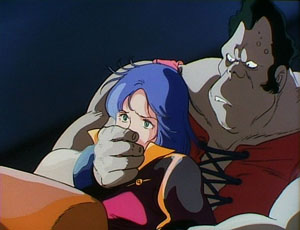 Both videos are pretty good as a whole, though. Director Takizawa Toshifumi (Dirty Pair: Flight 005 Conspiracy) used relatively higher-end animation techniques for a late ’80s OAV with detailed, shaded artwork and fluid movements while incorporating YAS’s character designs. The videos were aimed toward audiences in Japan who already knew Crusher Joe from the novels and local pop culture, so the screenplays by Fuyunori Gobu (Armor Trooper Votoms: Pailsen Files, Brave King Gaogaigar Final) don’t give much background about the characters. Still, The Crushers’ personality quirks come through just fine. Joe remains the dashing, levelheaded leader, Ricky and Talos bicker at times, while Alfin shows high spirits. Toshifumi and Gobu’s strengths complement each other in these OVAs, much as when both worked on the mech series Blue Comet SPT Layzner. One story element that was never really utilized in the anime, ironically, was the fact that Crusher Joe took place in the same universe with Dirty Pair, so fans who didn’t get to read Takachiho’s novels might not be aware of the characters’ previous interactions. For example, Talos dated Kei at one point until they broke up because of Bard’s scheming to get Kei for himself. This led to Talos taking the near-fatal mission where he was made into a cyborg.
Both videos are pretty good as a whole, though. Director Takizawa Toshifumi (Dirty Pair: Flight 005 Conspiracy) used relatively higher-end animation techniques for a late ’80s OAV with detailed, shaded artwork and fluid movements while incorporating YAS’s character designs. The videos were aimed toward audiences in Japan who already knew Crusher Joe from the novels and local pop culture, so the screenplays by Fuyunori Gobu (Armor Trooper Votoms: Pailsen Files, Brave King Gaogaigar Final) don’t give much background about the characters. Still, The Crushers’ personality quirks come through just fine. Joe remains the dashing, levelheaded leader, Ricky and Talos bicker at times, while Alfin shows high spirits. Toshifumi and Gobu’s strengths complement each other in these OVAs, much as when both worked on the mech series Blue Comet SPT Layzner. One story element that was never really utilized in the anime, ironically, was the fact that Crusher Joe took place in the same universe with Dirty Pair, so fans who didn’t get to read Takachiho’s novels might not be aware of the characters’ previous interactions. For example, Talos dated Kei at one point until they broke up because of Bard’s scheming to get Kei for himself. This led to Talos taking the near-fatal mission where he was made into a cyborg.
Fate would eventually bring Crusher Joe to the U.S., but it travelled a rocky road to get here. The movie was licensed from Enoki Films to Jim Terry Productions, which was famous in the early ’80s for bringing shows such as Getter Robo, Gaiking and Starzinger to America under the “Force Five” line. These shows were edited down and given bad dubs, and Crusher Joe’s fate was no different. Approximately 40 minutes of violence and nudity (and story) were cut from the 130-minute movie, and Joe’s voice was made uber-whiney for the English dub to appeal to kids, it seems. In 1988, the movie was renamed “Crushers” and released sparsely. (I only learned of it after watching the Bad American Dubbing compilation video by Corn Pone Flicks.)
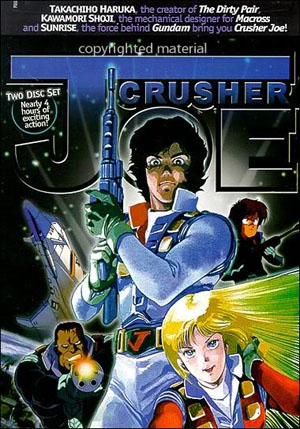
Fortunately, Crusher Joe was later licensed by AnimEigo who initially released all the anime to VHS in 1997. Each work was released separately, with the options for English dubs and English subtitles/Japanese audio available. The English dub was handled by Coastal Carolina Sound Studios, who did a much better job for the discerning anime fans. Michael Brady makes Joe sound like a competent bad-ass in this version. In 2002, AnimEigo released Crusher Joe as a 2-DVD collection, adding in extras such as a hidden trailer for The Ice Prison, and insert sheets with lyrics to the closing themes. This collection had good picture quality, nice looking subtitles and pretty decent audio. It’s very much worth tracking down. Unfortunately, the license has since lapsed so the collection is out of print and harder to find.
Still, if you can get any or all of Crusher Joe, you’ll be getting a kick-arse sci-fi series the likes of which isn’t made much in modern anime, which is a shame actually. Critics sometimes compare this show unfavorably to Cowboy Bebop. While it may contain some of the ’80s anime archetypes incorporated into Bebop, Crusher Joe has its own over-the-top style more akin to the likes of Space Adventure Cobra or Outlaw Star. The movie itself features early character design work by Rumiko Takahashi (InuYasha), Akira Toriyama (Dragon Ball) and Katsuhiro Otomo (Akira). So for both historical significance and entertainment value, you’d do well to check this series out. The DVD collection seems to be running about $80 on Amazon.com these days. Is Haruka Takachiho’s vision worth it? That’s up to you but I’ve honestly no reservations about recommending Crusher Joe to anyone.


![SSSS.Dynazenon [Anime Review] SSSS.Dynazenon [Anime Review]](https://otakuusamagazine.com/wp-content/uploads/2021/08/16-9-SSSS.Dynazenon_Key_Visual_3.5-480x360.jpg)
![Back Arrow [Anime Review] Back Arrow [Anime Review]](https://otakuusamagazine.com/wp-content/uploads/2021/07/ba15-02686-480x360.jpg)
